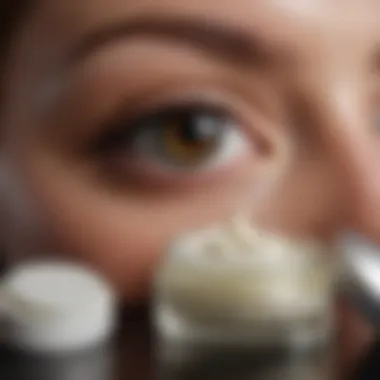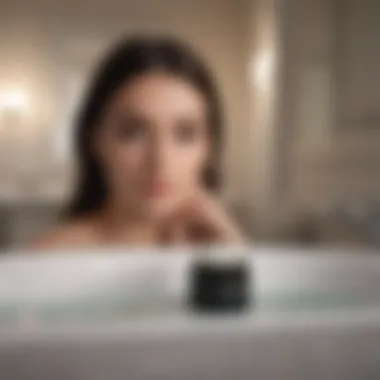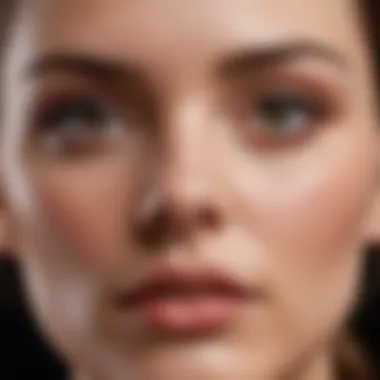The Ultimate Guide to Eye Creams for Flawless Makeup


Intro
In the modern beauty landscape, eye cream has emerged as an essential product for enhancing makeup application. The under-eye area is delicate and often susceptible to dryness, puffiness, and an as individuals we want the makeup to look flawless. Choosing the best eye cream can be a pivotal step for achieving that goal.
Using an appropriate eye cream provides hydration, reduces the appearance of dark circles and puffiness, and preps the skin to hold makeup longer. This guide focuses on the nuances of eye cream selection, the impact of various formulations, and effective application techniques. It also outlines the differences between eye creams and regular moisturizers to underline the importance of tailored skincare.
Moreover, insights into consumer preferences and ingredient knowledge can significantly influence the efficacy of an eye cream before makeup.
Fashion Trends
The intersection of fashion and beauty is dynamic and ever-evolving. As trends shift, so do the recommendations for skincare and eye care products tailored for makeup. Certain fashion trends not only dictate clothing but also impact makeup styles, influencing the preference for specific formulations of eye cream.
Runway Highlights
During major fashion's weeks around the globe, trends emerge that highlight the importance of a well-hydrated under-eye area. Designers often emphasize a glowing complexion, which directly correlates with the hydration and brightness provided by good eye creams. Notably, brands such as YSL Beauty and Tatcha have gained popularity due to standout runway looks where models flaunt radiant skin characterized by minimalistic yet fresh makeup.
Seasonal Must-Haves
As seasons change, so do the formulas of eye creams. For instance, during the winter months, thicker, richer creams may be favored to combat dryness. In contrast, lighter, gel-based formulas may suit summer, allowing for a refreshing feel without heaviness. Analyzing seasonal trends involves looking at the shifts in consumer preferences regarding hydration and coverage needs.
Celebrity-inspired Looks
Celebrities play a crucial role in shaping beauty trends. Many stars advocate for specific eye creams that help maintain a youthful appearance. For example, those like Rihanna and Gwyneth Paltrow often mention their favorite products, encouraging fans to explore formulations that provide similar benefits. This has created a ripple effect, prompting beauty enthusiasts to integrate similar products into their routines before applying makeup.
A well-chosen eye cream can truly transform the makeup application experience. When the under-eye area is smooth and hydrated, makeup glides on much easier and lasts longer.
Beauty Tips and Tricks
In pursuit of the perfect makeup look, several beauty tips can enhance the impact of your eye cream.
Skincare Regimens
Developing a consistent skincare regimen that includes eye care significantly sets out from the beginning how your makeup will appear throughout the day. A robust routine should incorporate gentle cleansing, which allows the right products to penetrate the skin effectively. If budget permits, consider customizable eye care collections like those from Kiehl’s or Estée Lauder.
Makeup Tutorials
Investing time in makeup tutorials focusing on eye makeup helps understand how to prepare the under-eye specifically. Techniques from skilled artists often emphasize the pre-application tips whether through color correction before concealing or optimizing the hydration using eye cream.
Hair Care Secrets
While focusing on eye care, implementing healthy hair routines, alongside effective skin care, elevates overall aesthetics. Hair health affects the perception surrounding your complexion. To achieve a polished look, ensuring that hair remains clean and styled complements eye makeup efforts.
Finale
In summarizing the complexities surrounding eye cream selection and the correlated enhancements to makeup application, it's fruitful to recognize the synergy between fashion and beauty. Here, clariifcations included adjustments to different elements have strong, layered implications for your entire appearance. Engaging with innovative products while appreciating current trends ultimately paves the pathway to capturing the ideal makeup halo.
Understanding the Importance of Eye Cream
The delicate skin around the eye area necessitates special care, especially when preparing for makeup application. An effective eye cream serves not just as an aesthetic enhancer, but as an essential component of any beauty regimen. It hydrates and nourishes this sensitive region, forming the basis for smoother makeup adherence. This layer of hydration is vital, as it helps avoid the unattractive dry patches that can adversely affect the look of your makeup.
Regular use of eye cream prior to makeup can yield numerous benefits. Key among them is the reduction of puffiness and evening out the skin tone, which contributes to an overall more polished appearance. Additionally, proper hydration prevents the makeup from clinging to fine lines, which can result in a more youthful and vibrant look.
Thus, incorporating eye cream into one’s routine sets the stage for successful makeup application. Ignoring the eye cream can lead to a range of problems, detracting from the desired effects of makeup products. This essential introduction advances the understanding of why utilizing a top eye cream is crucial.
Role of Eye Cream in Makeup Application
Creating a Smooth Canvas
Creating a smooth canvas is arguably one of the most significant roles that eye creams play in makeup application. The appearance of the skin around the eyes greatly determines how makeup performs in this area. An eye cream tailored for this task smooths fine lines and fills up any textural irregularities, allowing for a seamless application of concealer or foundation.
This smoothing effect enhances how makeup sits, making products like concealer blend effortlessly. When this base is created, it reduces the time spent on blending and correcting. A well-chosen eye cream enhances the efficiency of other products, translating to a quicker and more effective beauty routine.
Preventing Creasing and Settling
Preventing creasing and settling is another important aspect of eye creams. Fine lines and wrinkles are known to be magnified by dense or heavy makeup. Eye creams can help mitigate this by providing a consistent layer of moisturization. Thus, they create a barrier that lowers the chance of makeup settling into lines.
Such integrity encourages makeup to wear longer throughout the day. By ensuring that products remain smooth and uniform, the risk of a cracked or caked appearance is notably lessened. Additionally, avoiding creasing prevents the need for frequent touch-ups, further enhancing the appeal of enduring makeup looks.
Differences Between Eye Cream and Regular Moisturizer
Formulation Variations
Formulation variations are another fundamental component that distinguishes eye creams from standard moisturizers. The skin surrounding the eyes is thiner and often more sensitive than skin on other parts of the face. Consequently, eye creams typically have lighter formulations that allow for better penetration without risking irritation. These products usually include fewer emollients and focus more on hydration and treatment rather than pure moisturization.
Moreover, many eye creams are designed to be absorbent, offering quick hydration with minimal residue. On the contrary, rich moisturizers can be heavier and intended for more general use, potentially leaving behind an undesired film that can affect makeup application.
Targeted Ingredients
Targeted ingredients are a key area where eye creams show their strength when compared to regular moisturizers. Eye care products commonly contain specific components that cater to typical concerns like dark circles and puffiness. Ingredients such as caffeine can aid in circulation, while peptides might facilitate skin renewal. In contrast, standard moisturizers focus on broad benefits with ingredients aimed at overall skin hydration. They may not address the particularized needs of the eye region.
Key Ingredients in Eye Cream


Selecting the right eye cream involves understanding its ingredients. The effectiveness of an eye cream is often tied to its formulation. Ingredients play a critical role in not just moisturizing but also targeted treatment of various issues, such as puffiness, dark circles, and early signs of aging. Focusing on beneficial components can enhance your makeup application and the health of your skin.
Hydrators
Hyaluronic Acid
Hyaluronic Acid is a well-known ingredient in skincare. It is exceptional for its ability to retain moisture. This ingredient can attract and hold many times its weight in water, making it crucial for keeping the under-eye area hydrated. A more hydrated surface helps in creating a smoother application for makeup, reducing the risk of cracks and emphasizing fine lines.
One significant quality about Hyaluronic Acid is its lightweight texture. This makes it a popular option in many eye creams, where heaviness can often weigh down the delicate skin around the eyes. Despite its benefits, individuals with more oily skin types may find its hydrating properties somewhat excessive, so they should choose formulations with lower concentrations.
Glycerin
Glycerin is another highly valued ingredient when it comes to eye creams. It serves as a humectant that draws water to the skin from the surrounding environment. This component ensures that the under-eye area stays plump and hydrated throughout the day. That is essential when planning for makeup application, giving skins a prepared, velvety texture.
A key characteristic of Glycerin is its safety profile. Often suitable for various skin types, Glycerin rarely causes irritations. Its unique formulation allows it to work well in tandem with other hydrating ingredients. However, using overly rich formulations could potentially lead to greasy residues, which might not be ideal for professional makeup looks.
Anti-aging Components
Retinol
Retinol is popularly known for its anti-aging benefits. This vitamin A derivative encourages cell turnover, allowing skin to shed dull layers more efficiently. Using eye creams containing Retinol can lead to a noticeable reduction in fine lines or wrinkles around the eyes. When planning for makeup application, a well-renewed surface can enhance the overall appearance.
Retinol is indeed powerful. However, beginners must be cautious, as it can cause irritation, particularly for sensitive skin. Therefore, if using Retinol eye creams, it's wise to start slow to give the skin a chance to adjust.
Peptides
Peptides are short chains of amino acids that contribute to protein synthesis in the skin, particularly collagen. These ingredients promote firmness, helping to improve elasticity or diminish signs of sagging. In eye creams, their presence signifies a focus on enhancing the skin's internal structure, which is vital for maintaining a youthful look during makeup application.
Distinctively, peptides are often praised for their anti-inflammatory properties. This can be beneficial for reactions to other ingredients or for users prone to puffiness. On the downside, the results from using Peptides can take significant time to manifest, thus requiring patience and consistent use.
Brightening Agents
Vitamin
Vitamin C stands out primarily for its brightening effects on the skin. As an antioxidant, it helps in combating free radicals and reduces oxidative stress. With regular use of eye creams that contain this vitamin, one could experience a brighter under-eye area, effectively addressing dullness and dark circles that often accompany fatigue or aging.
The characteristic of Vitamin C in eye creams is significant: it not only brightens but is also vital for collagen synthesis. However, it’s important to check the stability of Vitamin C in any formulation as unstable compounds can lose effectiveness upon exposure to air or light.
Niacinamide
Niacinamide is emerging as a favorite among many skincare enthusiasts. Known for its versatility, it contributes to various skin concerns: it improves the skin barrier, reduces inflammation, and addresses pigmentation issues. For those wanting radiant skin, Niacinamide is a favored choice in eye creams as it gradually enhances the overall skin tone.
Choosing the Right Eye Cream for Your Skin Type
Choosing the correct eye cream for your specific skin type plays a significant role in enhancing your overall makeup application. The eye area is delicate and vulnerable. Using an unsuitable product can lead to issues like irritation or inadequate moisture, which can affect makeup performance. It is essential to know the unique requirements of your skin to guarantee the best results.
For Oily Skin
Lightweight Formulations
Lightweight formulations serve as an excellent choice for those with oily skin. These products typically absorb quickly and do not leave any heavy residue, which is crucial for maintaining freshness throughout the day. Fatty alcohols and oils that can exacerbate oiliness are often absent in these formulations, making them ideal for those looking to avoid unwanted shine.
However, caution is needed. Some users may find lightweight creams lacking in moisture. Therefore, while they are effective, it is also important to test different products to find one that provides a sufficient level of hydration without increasing oiliness.
Oil-Free Options
Oil-free options take the characteristics of lightweight formulations a step further. As the name suggests, these creams eliminate oils entirely, utilizing water-based ingredients instead. This can be a significant advantage for oily skin types as it often reduces the risk of clogged pores.
The unique benefit of oil-free products is their remarkable ability to hydrate without adding extra oil. However, one should be aware that some of these formulations may be less moisturizing overall. Therefore, finding a balance is important, as overly drying products could lead to another set of issues.
For Dry Skin
Rich Textures
Rich textures are crucial for individuals with dry skin. These creams tend to have a thicker consistency, often due to the presence of heavier emollients and occlusive agents. These ingredients create a protective barrier that locks in hydration, essential for alleviating dryness in the eye area.
The benefit of using a rich-textured cream is evident; it provides an intensive level of moisture that can significantly improve skin surface issues like flaking or dullness. Users should, however, be careful. With overly rich sources, application can lead to product settling into fine lines, especially if applied too liberally. Testing for compatibility is also advised.
Emollient Ingredients
Emollient ingredients, on the other hand, focus more on softening and soothing the delicate skin around the eyes. These ingredients are commonly found in creams suitable for dry skin types. Examples of such ingredients include shea butter and various oils that possess nourishing qualities.
These softeners provide compression and hydration, allowing for skin plumpness. The main challenge, however, is to ensure that products with too many heavy ingredients do not result in a greasy feel. Regular uses may solve many issues, but a certain degree of caution is still necessary.
For Sensitive Skin
Fragrance-Free Products
Fragrance-free products are typically advised for sensitive skin types. Adding fragrance in skin palettes often leads to irritations or adverse reactions in sensitive facets, painting a bleak picture for those who just want healthy skin. By opting for fragrance-free options, individuals can significantly reduce the risk of triggering sensitivities.
This plural-only aspect is often highlighted as significant. However, while fragrance-free does reduce a layer of risks, it should still be noted that sensitivity may derive from other mosters too; therefore, checking all ingredients is advised.


Soothing Ingredients
Soothing ingredients produce immediate comfort to the skin, especially for those prone to reactions. Ingredients such as aloe vera extract or chamomile can calm inflammation and reduce redness effectively. The soft texture and careful construction of such items often make them a popular choice for those experiencing discomfort.
Nonetheless, these soothing mechanisms might not deliver maximum hydration that some may desire. Therefore, alignment with another hydrating product can complement these soothing campaigns. Always check sensivity before traing larger amounts.
Application Techniques for Optimal Results
When it comes to applying makeup, using the right application techniques for your eye cream can significantly enhance your overall look. The delicate area around the eyes requires careful attention. Proper techniques help ensure even distribution of product, preventing issues like puffiness and dry patches after makeup application. Notably, accurate methods improve absorption and help shield the skin.
Proper Application Methods
Using Gentle Tapping Motions
Applying eye cream can be all about technique. One recommended approach is using gentle tapping motions. This method promotes better absorption and circulation. Tapping activates the lymphatic system, helping to reduce any swelling. Its biggest advantage is that it is a softer approach which doesn't irritate the sensitive skin.
Key Characteristics: Using gentle tapping keeps the skin intact while ensuring the cream penetrates deeply. This technique requires patience but makes a noticeable difference after consistent use. By facilitating a natural drainage process, the eye cream works more efficiently to reduce puffiness.
Disadvantages: However, this method requires time. In a hurry, individuals may forget to tap or rush through it, leading to ineffective results.
Applying the Right Amount
Equally important is how much eye cream you apply. Using the right amount is crucial for effectiveness. Too much product can create a heavy layer that feels uncomfortable or leads to makeup sliding off. Eye creams are designed to be lightweight. A pea-sized amount is usually sufficient for both eyes, ensuring that you get the benefits without overwhelming the skin.
Key Characteristics: This feature balances hydration and ensures the area stays hydrated throughout the day. A correct dosage allows for better blending into areas requiring attention, such as dark circles or fine lines under eyes.
Disadvantages: If too little product is used, the area may feel dry, impacting your makeup's application. A balance is crucial for optimal results and comfort.
Timing Your Application
How Long Before Makeup
Timing plays an important role in ensuring that your eye cream works effectively. Applying your eye cream well before putting on makeup is necessary to allow adequate time for absorption. A general guideline is to wait at least 5 to 10 minutes before proceeding with makeup. Waiting lets the cream settle into the skin rather than sitting on top of it, allowing your makeup to go on smoothly.
Key Characteristics: Understanding this timing can make a substantial difference in makeup longevity. When the eye cream is absorbed properly, it provides a hydrated base which enhances the overall appearance of the eye area.
Disadvantages: Gaps in timing can lead to slippery makeup. Not waiting enough spurs the foe of excess shine or unevenness in application.
Integrating into Your Routine
Lastly, integrating eye cream into your overall skincare routine matters greatly. The factor of consistency cannot be overlooked when looking for long-term results. Making eye cream application a regular aspect of daily skincare can boost the impact those hydrating and brightening effects has over time.
Key Characteristics: Establishing a habit of applying eye cream can help develop healthy skin over time. Those who connect it with other routines, such as putting cream on before they sleep or twenty minutes prior to makeup application, often experience improved results.
Disadvantages: A lack of integration can result in neglect, reducing the product’s effectiveness. Remembering to use it every day may seem daunting; however, setting time aside can yield positive skin outcomes.
Proper methods in applying eye cream prior to makeup directly impact your final look, offering smoother application and improved results.
Popular Eye Creams to Consider
The selection of effective eye creams plays a pivotal role in optimizing makeup application. It serves two main purposes: enhancing skin hydration and providing a nurturing base for makeup to adhere effectively. Many people overlook the significance of eye creams and often compromise their overall appearance. Knowing the best options available ensures that you can achieve a flawless look while addressing specific skincare needs.
Top Picks for Drugstore Brands
Affordability and Effectiveness
Drugstore brands often present a compelling combination of affordability and effectiveness. Eye creams from such brands usually contain key ingredients that might also be found in luxury alternatives, making them smart choices. For many budget-conscious beautyj enthusiasts, this is especially appealing. The common characteristic of these products is their accessibility; they do not require investment draining of the wallet. A high-benefit factor with such products is the variety in formulations, ensuring that most skin types can find a suitable option. However, they may not perform as powerfully as premium products. Performance thus varies, which necessitates genuine consumer evaluation.
Consumer Reviews
Consumer reviews can offer deep insights about eye creams, delving into real-world performance of these products. Reading such evaluations is a practical way to gauge effectiveness and understand any personal biases for skin responses. Peer reviews often highlight the effectiveness or failure of a product and help prospective buyers make informed selections. A collective consciousness about expectations regarding different formulations and their actual results facilitates smarter purchasing decisions. Importantly, the community provides details on various aspects like texture and observed results, either reinforcing the popularity of a product or exposing its limitations.
Luxury Eye Creams Worth the Investment
High-Performance Ingredients
When exploring high-end eye creams, high-performance ingredients emerge as a key focus. These products frequently utilize breakthroughs in skincare tens technology, maximizing benefits such as hydration or wrinkle reduction. Many luxuriously formulated eye creams may incorporate highly endorsed elements like antioxidants and peptides that are scarce in budget options. Their unique characteristic is often the synergy of quality with scientific validation, leading to noticeable results. Though investment-heavy, their potency often distinguishes them, thus considerably improving the chance of a successful beauty regimen. However, for some, the price-point may provoke hesitance based on expected outcomes.
Brand Reputation
Brand reputation contributes significantly to the luxury segment's standing. Consumers have preferences for established names, often tied to their marketing power and commitment towards sustainability or non-animal testing. The excellent reputation serves a comfort factor, boosting assurance regarding quality control and production integrity. In fact, many loyal users prefer to pay a premium due to the psychological reassurance of receiving a reliable product backed by a company’s legacy. The caution to exercise stems from cases where innovation might place importance on branding over resource effectiveness. This means thoughtful examination might sometimes uncover better or equally effective, less expensive alternatives.
Eye Creams and Makeup Interactions
The interaction between eye creams and makeup plays a pivotal role in achieving a polished look. Using the right eye cream can set the stage for successful makeup application. It increases hydration and reduces the chances of makeup disrupting over time. It is essential to find a balance, as an unsuitable product can lead to undesirable outcomes like smearing, creasing, or uneven texture.
Compatibility with Foundations
Liquid versus Powder
When discussing liquidity in makeup, liquid foundations present distinct features. They tend to offer a dewy finish that complements hydrated skin well. By using a suitable eye cream, the skin can absorb moisture, leading to better blending. Liquid formulations generally glide smoothly on the skin. It ensures minimal settling of makeup into fine lines.


In contrast, powder foundations provide coverage but may emphasize dry areas. An eye cream that settles well into the skin can counterbalance any dryness. This interplay often allows for lasting results, making liquid a typically beneficial choice.
Makeup Formulations
Beyond liquidation, make-ups formulations vary widely. Cream-based products, for example, can protect moisture levels even further. They work cohesively with eye cream to bolster skin texture underneath concealer or shadow. The texture fosters an adaptable climate for the overall make-up effect.
On the other hand, matte formulations can sometimes tighten or age the delicate under-eye area. Pairing these with the right eye cream is critical for promoting a balanced look. The features of both types ascertain that there’s significance in what eye cream is chosen with specific formulations.
Setting Techniques for Longevity
Proper setting techniques can significantly enhance makeup longevity, especially when using eye cream. The application and finishing methods impact how all products wear during the day.
Setting Sprays
Setting sprays emerge as an excellent weapon against fading. When used correctly, they can lock in hydration without overruling the moisture provided by the eye cream. They form a stable barrier, ensuring the makeup remains intact for hours.
Their key characteristic, lightweight feel, makes them comfortable for all skin types. Choosing the right formulation is crucial, as some may include hydrating elements that benefit the under-eye area.
Powder Applications
Powder applications offer another method of durability. This can add structure and blurring to imperfections for the eye area often best when managed deftly. They can serve as a matte finish, balancing shine while controlling creasing. The dexterity lies in minimizing the final step rather than inundating already tender areas.
Nevertheless, powder must be used in moderation. Incorrect amounts can lead to an overly dry or chalky appearance. Attention to how it interacts with your chosen eye cream is vital. A finely milled formula is recommended in these cases to avert any distress.
The interplay between eye cream and makeup formulations cannot be underestimated for harmony in any beauty regimen.
By thoughtfully considering these interactions, beauty enthusiasts can craft elegant and graceful looks that enhance their features while promoting their overall skin health.
Common Mistakes to Avoid
When it comes to applying eye cream before makeup, many make simple errors that can impact the effectiveness of their beauty routine. Recognizing and correcting these mistakes can make a notable difference in both skin health and makeup results. In this section, we explore two common oversights: using too much product and neglecting absorption time.
Using Too Much Product
Understanding the Right Dosage
Applying the correct amount of eye cream is essential. Too much product can lead to a sticky layer that interferes with the makeup application. Generally, a pea-sized amount is enough for both eyes. This quantity allows for even coverage without overwhelming the delicate skin around the eyes.
Using the right dosage ensures that the skin properly hydrates without creating a slippery surface. If there is too much cream, it increases the risk of makeup sliding off during the day. Be mindful not to overdo it. Excess product is wasteful, and adjusting your usage can lead to effective results when applying makeup.
Key Advantages
- Ensures an even base for makeup.
- Prevents skin irritation from excess product.
Impact on Makeup Application
Too much eye cream greatly affects how makeup adheres to the skin. The absorbency of the eye area is critical. If the skin is saturated, foundations or concealers may shift or pool into creases. Lightly moisturizing is beneficial as it increases smoothness and avoids cracking or settling. Once you have dialed in the right amount of cream, observe how it transforms your makeup's longevity.
Key Characteristics
- Enhances makeup's wearability from morning through evening.
- Allows for a more natural appearance rather than a heavy or concealed look.
Neglecting to Allow Absorption Time
Why Waiting is Essential
Once the eye cream is applied, patience is required. Allowing time for the product to absorb adequately leads to better makeup application. Rushing into makeup after applying eye cream means the product is not given the chance to sink in, which significantly reduces its benefits. Skin benefits from absorption, leading to hydration and a smoother surface.
Key Benefits
- Ensures that the ingredients penetrate deeply.
- Reduces the likelihood of makeup separation or roll-off during wear.
Timing with Other Products
Proper timing is not only about the waiting period after applying eye cream but also how it fits into your overall skincare regimen. Eye cream should generally be applied after your cleanser but before any makeup products. If you use other treatments or moisturizers, adding those after the eye cream demands additional timing consideration. Keeping layers organized will promote better results in the long run.
Commendable Features
- Maintains an effective skincare routine.
- Aligns with how products interact to ensure full benefits.
Timely allocation of skincare allows makeup followers to ensure their routine is streamlined. Avoid common missteps concerning doses and timing, enhancing your approach to both makeup application and skincare.
Epilogue
The conclusion ties together all insights presented throughout this guide. Understanding the importance of eye cream in the makeup routine cannot be understated. A well-chosen eye cream not only hydrates the delicate under-eye area but also serves as a crucial preparatory step before makeup application. The right formulation can lead to smoother applications, minimize the appearance of fine lines, and reduce the likelihood of creasing during the day.
Key elements to consider include ingredient qualities, skin type compatibility, and application techniques. Recognizing the difference between an eye cream and standard moisturizer is vital for selecting the correct products suited for unique needs. Proper absorption times and amounts significantly influence the overall effect and longevity of makeup. Given these factors, paying attention to each detail in your regimen may greatly benefit your aesthetic outcomes.
Adopting this thorough approach to eye creams means achieving a seamless foundation for your makeup—not merely covering flaws but enhancing your natural features. In a world where first impressions often hinge on appearance, equipping oneself with knowledge of effective products is both practical and imperative.
Final Thoughts on Choosing and Using Eye Cream
Choosing and using eye cream encompasses more than simply picking a product off a shelf. It demands awareness of your own skin prerequisites, makeup needs, and environmental influences affecting skin. Factors such as age, climate, and daily skincare routine play significant roles in the decision-making process.
- Look for formulations that articulate your particular skincare goals.
- Evaluate textures and weights to ensure comfort during wear.
- Prioritize ingredients designed with hydration and nourishment in mind.
One must also engage with consumer reviews and scientific research to substantiate choices. Clear communication with skin care professionals can bring further clarity to what may initially seem overwhelming.
Ultimately, taking the time for consideration can lead to significant improvements in the outcome of makeup application and overall skin health. Making educated decisions fosters both immediate and long-term benefits for looking and feeling one’s best.















